In the parlor of a fashionable London townhouse, two sisters sit beside each other. Their backs are straight, legs uncrossed, hands resting primly in laps. Uncomfortable smiles curl their lips. Silence muffles the room as the siblings await conversational overtures from the domineering matron who stares indulgently back at them. One sister cuts the tension by admiring a decorative pillow. An awkward exchange of pleasantries follows, with the three women talking of fashion and men, before canapés and a bumbling patriarch arrive to divert their attention.
This scene, which might be plucked from any one of Jane Austen’s novels, occurs in the fifth episode of Emmy-winning television series Fleabag (2016–2019), created by and starring Phoebe Waller-Bridge. Fleabag’s parallels with Austen’s Regency extend beyond unnerving luncheons, though. In this modern Bildungsroman, a snarky thirty-something millennial fumbles to find her professional, familial, and romantic footing. Burdened with a dying café, a dead best friend, a deceased mother, and a string of dead-end relationships, Fleabag (Waller-Bridge) is stuck navigating a world far better suited to her sister, Claire (Sian Clifford), the financially stable, socially sensible, and sexually frustrated woman whose career, marriage, and wardrobe mark her as the golden child. (“I have two degrees, a husband, and a Burberry coat,” Claire fumes, when Fleabag mocks how Claire once “shat in a sink” [Season 1, Episode 1]). Claire’s repressed containment offsets Fleabag’s messy excess, and the two “are played off each other, presented as a successful neoliberal subject and a failed one, respectively” (Darling 2).
Readers of Sense and Sensibility may hesitate to draw such easy sibling dichotomies. For while “starkly contrasting moral qualities” have commonly positioned Marianne and Elinor Dashwood at “opposite ends of a forced binary” (May 340; Witherington), Austen challenges this “fictive dichotomy . . . from the beginning” (ApRoberts 355). So, too, does Fleabag. In both contexts, nuanced complexities between sisters have been superseded by critical attention elsewhere: on men, marriage, money, even mothers. Those who do orient us to the “compass of sisterhood,” affirming that “every other relation in the text is secondary” (Dabundo; Thompson), tend to gesture to motifs of sororal affection, love, and support, such as Glenda Hudson does in foregrounding the “harmonious sibship” (5) that, she argues, Austen uses to model egalitarian communities where “ideal marriage” replicates “ideal sisterhood” (Lanser 54). This essay extrapolates sisterhood from affinal systems altogether. I explore, instead, how siblings navigate each other’s changing—and, often, unchanging—natures.
Bringing these texts together, like two siblings seated upon a sofa, I propose that Austen and Waller-Bridge cultivate a Bildungsroman of “we” rather than “I.” Scholars of the so-called “female” Bildungsroman have alluded to such a broadening, extending the “male” tradition of individualism into more relational and communal modes. Yet they often overlook reciprocal influence in such relationships in favor of the kind of “inner development” and “greater self-knowledge” that derive from “learning to see oneself” accurately.1 While I do not discount the presence of a subjective lens here—Austen’s free indirect discourse and Waller-Bridge’s breaking of the cinematic fourth wall command, after all, a certain narrowing of perspective—I offer a reading of mutual evolution. Pairing Marianne and Elinor with Fleabag and Claire, this essay tracks how each sibling’s development hinges upon a willingness to see her sister, rather than herself (or a suitor), anew. Only after embracing this refreshed vantage point does each permit change within herself, expressing traits once presumed exclusively the domain of the “other.” Austen and Waller-Bridge thus unpack the intricacies of sororal interdependence, placing siblings at the heart of the Bildungsroman.
Sisterly (dis)similarities
In both Sense and Sensibility and Fleabag, it is the sisters who insist upon binaries. Each woman feels that her counterpart acts and thinks differently from herself, therefore is different. Both Dashwoods repeatedly infer the other’s alterity: Elinor senses Marianne’s “behaviour” to be “so exactly the reverse of her own” (121), whereas Marianne repeatedly announces, “‘Elinor has not my feelings’” (20). At one point, Elinor predicts that “‘[a] few years however will settle [Marianne’s] opinions on the reasonable basis of common sense and observation’” (66); in other words, Marianne will one day become like Elinor, which she presumably is not now. Similarly, when Marianne concludes that Edward “‘has no real taste’” (20), she supposes Elinor remains oblivious to aesthetic concerns. Elinor must convince Marianne that she, too, has “‘studied his sentiments’” (23). The novel’s ostensible dualism—sensibility versus sense—pits Marianne’s aesthetic romanticism against Elinor’s buttoned-up propriety because the sisters themselves reinforce these assumed polarities, even when misconstrued.
Those presumptions may feel familiar. We often believe we know who our siblings are, regardless of how they behave in reality. One psychologist describes this common scenario:
Imagine if you can, both your spouse and yourself as being 95 years old and married for 70 long years. After such a long time period, each knows fairly well what to expect of the other, what the other is going to say and do. Similarly, after many years of interacting and communicating, the siblings’ characteristics solidify, and may evoke stereotypic responses from one another during interactions; thus interaction has little likelihood of altering characteristics. (Cicirelli 20)
Over seventeen years of mutual knowing, Elinor and Marianne are unlikely to see one another differently; their expectations have solidified, and each filters the other’s behavior through her preconditioned lens. Accordingly, Elinor forecasts Marianne’s reactions because “[s]he knew her sister’s temper” (69). Readers have inherited this preconditioning. When Libby Bagno-Simon, for example, claims that Elinor is “remarkably different from her mother and sister” (par. 19), she cites Elinor’s frequent disappointments: “She knew that what Marianne and her mother conjectured one moment, they believed the next” (SS 24, qtd. in Bagno-Smith par. 19); “From their counsel, or their conversation she knew she could receive no assistance” (SS 162, qtd. in Bagno-Smith par. 20). In both instances, however, Austen’s telling phrase “she knew” indicates how subjective these (mis)perceptions may be.
Indeed, Austen’s authorial voice erases any straightforward duality between Elinor and Marianne. When first characterizing Elinor, the narrator informs us that her “strength of understanding” and “coolness of judgment” are complemented by an “excellent heart” and “affectionate” “disposition” in which the “feelings were strong.” Marianne, likewise, is said to balance emotion with reason: though “eager in every thing,” the younger sister inclines to be both “sensible and clever,” in some ways “quite equal” to Elinor (7). Though the sisters may see one another as oppositional, the novel does less so.
Fleabag likewise complicates Fleabag’s and Claire’s assumed incompatibilities. When Fleabag hands Claire a slice of cake for the latter’s birthday, for instance, Fleabag declares confidently to the camera, “She won’t eat it.” But Claire lifts the lid and digs in (Season 1, Episode 3).

A Birthday Surprise.
©Two Brothers Pictures and Amazon Studios
Such ironic undercutting repeats throughout the series. In the first episode, Fleabag rushes to her seat in a lecture hall, breaking the fourth wall to introduce us: “My sister. She’s uptight and beautiful and probably anorexic but clothes look awesome on her so . . .” Moments later, Fleabag reasserts their disparities, describing Claire as her “super high-powered, perfect, anorexic, rich, super sister” who, if Fleabag would only ask, could bail her out (Season 1, Episode 1). After the lecture, Claire moves to hug Fleabag, but Fleabag swipes to defend herself. Their differences could not be more striking.
Yet Fleabag’s camera frames a different story. When someone crosses their auditorium row, the sisters pause mid-argument to stand simultaneously to let the person pass, smiling and muttering apologies. When the lecturer polls the women in the audience, prompting, “Please raise your hands if you would trade five years of your life for the so-called ‘perfect body,’” Fleabag and Claire shoot their arms into the air. They are the only two. As both sink into their seats, Fleabag murmurs their shared embarrassment: “We are bad feminists” (Season 1, Episode 1). Moments like this reveal how the sisters respond in kind to the outside world.
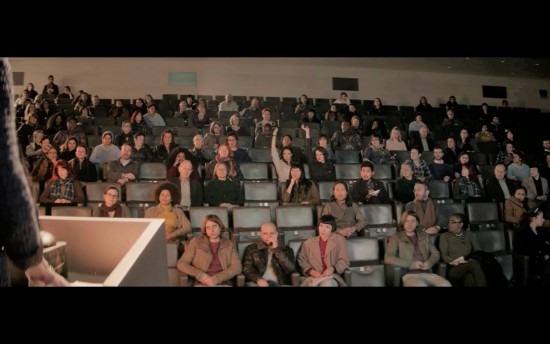
"Bad Feminists."
(Click here to see a larger version.)
©Two Brothers Pictures and Amazon Studios
That parity is reasserted during the sisters’ trip to a “female-only” silent retreat, an excursion their father has sponsored, just like the feminist lectures to which he sends them. Superficially, the women are separated by their purchasing power: as Claire unpacks a fortune’s worth of creams, Fleabag pesters, “What’s that for? . . . What’s that for?” while Fleabag, in contrast, has brought one nondescript jar “for my face and body” (Season 1, Episode 4). But when the women sit cross-legged in the retreat center, listening to yet another presenter lecturing them on femininity, the sisters steal sideways glances, purse their eyebrows in unison, and channel their shared incredulity. Later, facing the schoolmarm-ish retreat leader who reprimands them for their outbursts, Fleabag and Claire flout her like two petulant teenagers. Leader: “Your flagrant lack of respect is now affecting the other students—er—clients.” Fleabag: “Inmates?” Claire: “Cleaners?” Without missing a beat, the sisters exchange mocking looks. They face external forces with irrefutable synchronicity.
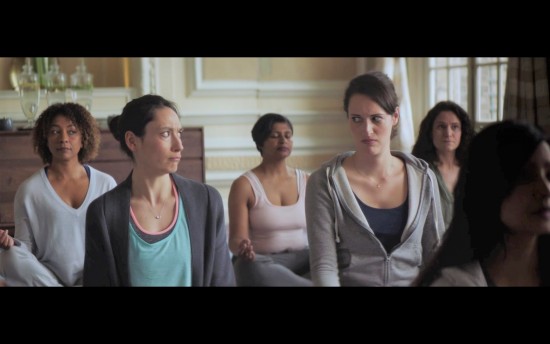
Frowning at “Silent” Feminism.
©Two Brothers Pictures and Amazon Studios
Even in Sense and Sensibility, disparate sisters can react similarly to outside events, such as their new home at Barton (“their interest . . . overcame their dejection, and a view of Barton Valley as they entered it gave them cheerfulness” [33]), or to outside actors, as when they refuse collectively a visit with Mrs. Palmer (“They thanked her; but were obliged to resist all her entreaties” [128]; “They both eagerly and resolutely declined her invitation” [130]). We are reminded, at times, of Elinor’s emotionality—which Marianne refuses to observe—as when Willoughby’s rapid departure leaves Elinor in a “disturbed” state of “uneasiness,” with “anxiety and distrust” (89). And, indeed, there are moments when the sisters dance around their underlying similarities. Disagreeing over the necessity of money, for instance, Elinor jests that differences in terms belies their shared beliefs: “‘we may come to the same point. Your competence and my wealth are very much alike, I dare say’” (105). Elinor even approaches admitting that her preconceptions prevent her from judging her sister fairly, as she “‘fanc[ies] people so much more gay or grave, or ingenious or stupid than they really are,’” unable to “‘tell why, or in what the deception originated’” (108). She does not yet include Marianne in this category.
Blame and betrayal
Since each sibling has codified such a dogged archetype for the other’s character, betrayals arise when the other disrupts this vision. Fleabag and Sense and Sensibility both climax with sororal tensions that result from such perceived betrayals. At the end of the first season, Claire throws Fleabag a slew of mixed messages: after expressing frustration at having to care for her “broken sister,” Claire tells Fleabag that she plans to leave her husband, give Fleabag money to keep her café afloat, and go to Finland, where her new job and destiny await (Season 1, Episode 5). Fleabag nods with a tinge of disbelief: “Okay.” After all, Fleabag knows her sister well enough not to expect these events to transpire. (She understands her sister’s idiosyncrasies so intimately, in fact, that she can detect when the appearance of braided “plaits” or polka-dotted shoes signal Claire’s attempts at reinvention, driven either by a life crisis or her menstrual cycle.) These new pronouncements do not fool Fleabag.
Yet she is fooled. Claire shocks Fleabag by producing evidence for this change of heart: their godmother’s sculpture. Claire has re-stolen the object, in a literal imitation of Fleabag’s earlier rebellion. “That is the coolest thing you’ve ever done,” Fleabag tells Claire (Season 1, Episode 5). With both women outfitted in collared shirts, each draping a trench coat over her left arm, Fleabag and Claire are unified visually in a medium shot, no longer clipped apart by alternating close-ups. Poised together against the backdrop of their father’s home—the battleground occupied by their usurping godmother—they are united against this familial world. They also finally manage that hug (“Shall we . . ?” “We can try”).
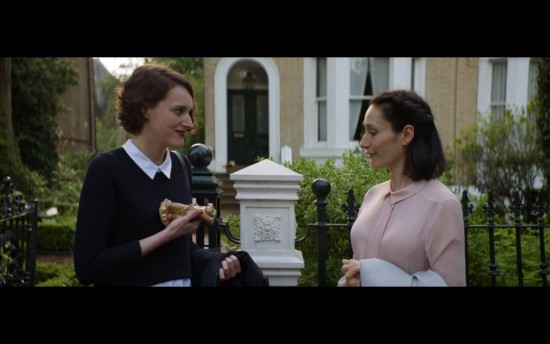
The Repurloined Sculpture.
©Two Brothers Pictures and Amazon Studios
When Fleabag next sees Claire, however, she is fooled again, for Claire shows up with her husband, Martin. Having glimpsed a potential break in Claire’s restrictive cocoon, Fleabag is flabbergasted by this departure. In reality, though, Claire has not changed a bit. She sustains the same self-denying decorum that Fleabag has always associated with her. Fleabag is upset simultaneously by Claire’s refusal to change and by her living up exactly to Fleabag’s expectations. Claire devastates Fleabag by refusing to believe her accusation that Martin has made a pass at her:
“Claire, you have to believe me.”
“How can I believe you?”
“Because I’m your sister.”
“After what you did to [your best friend] Boo?” (Season 1, Episode 6)
Her truth thrown back in her face, her sisterly confidences broken, this betrayal undoes Fleabag. Close-up shots capture Fleabag’s distress as she attempts to back away shakily from the camera’s accusatory glare, while the soundtrack strikes erratic jazz chords resonant of a David Lynch noir film. Flashbacks reveal that Fleabag had slept with Boo’s boyfriend, propelling the best friend’s accidental suicide. Following this sequence, the sisters do not speak for a year, Fleabag stunned that Claire both is and is not the woman Fleabag thinks she is.
As this scene illustrates, sibling intimacy can backfire. In Sense and Sensibility, a similar climax between Elinor and Marianne highlights the way sibling distrust can escalate after a lifelong series of repeated offenses. Elinor and Marianne’s mutual wariness stems from mutual secrecy. Hoping Elinor might confide in her—yet knowing, based on experience, that she will not—Marianne, like Fleabag, is distressed by Elinor’s consistent lack of openness. Their frustrations explode in London:
After a short pause, “you have no confidence in me, Marianne.”
“Nay, Elinor, this reproach from you—you who have confidence in no one!”
“Me!” returned Elinor in some confusion; “indeed, Marianne, I have nothing to tell.”
“Nor I,” answered Marianne with energy, “our situations then are alike. We have neither of us any thing to tell; you, because you communicate, and I, because I conceal nothing.” (193)
Both of these sibling spats stem from distrust: Elinor protests that Marianne has no confidence in her; Fleabag, that Claire must. Expectations of honesty have previously been disavowed on both sides, however. Marianne, furious that Elinor behaves predictably, blames Elinor’s reticence for their troubles, reinforcing their opposition: Elinor “communicate[s] . . . nothing”; Marianne “conceal[s] nothing.” Repeated pronouns—“you,” “me,” “I”—express each sister’s desperation to blame the other. Each is hurt that her sister has acted consistently like herself and that she has not been able to change (which might have amounted to another kind of betrayal altogether).
Not being spoken to makes Marianne feel unheard. Fleabag is likewise frustrated by Claire’s frequent concealments: “you’re just going to have to tell me what’s going on with you. Talk! Or I will scream” (Season 1, Episode 4). Marianne punishes Elinor with further silence, perpetuating an absence of “sisterly chat” between the siblings (Mullan 66). Their falling-out in London occurs in tandem with the romantic plotlines—Willoughby’s avoidance and Lucy’s revelation of her engagement—yet neither sister explains this pivotal situation to the other. Their selective silence echoes across subsequent interactions, and their muteness resounds loudly:
“Marianne, may I ask?”—
“No, Elinor,” she replied, “ask nothing; you will soon know all.” (205)
Though Elinor may soon “know all,” Marianne coldly conveys that she may not be the one to tell her.
Confession and change
Following these betrayals, Sense and Sensibility and Fleabag see each woman overcome her own psychological preconditioning in order to reevaluate her sense of her sister’s character and to allow her sister to change in her eyes, before ultimately changing herself. Each transforms in response to the other, only by recognizing in the other the capacity for acting in a manner she had assumed the other incapable of. Apropos of the courtship plot, each protagonist appears at first to evolve in response to a suitor—Elinor becomes emotional with Edward’s return; Fleabag spews vulnerabilities to The Priest—yet each sister exposes herself as a result of becoming willing to see her sister differently.
Fleabag’s assumptions about Claire begin to dismantle when, after a professional event that Fleabag caters for Claire, the older sister reveals long-held insecurities: “Because you’re fine. You’ll always be fine. You’ll always be interesting with your quirky café and your dead best friend. You just make me feel like I failed.” Fleabag is shocked; reading Fleabag’s mind, and expression, Claire threatens her own vocal theatrics, retorting, “If you mention the size of my office I will scream” (Season 2, Episode 3). That Claire, with her gigantic office and designer closet, could harbor resentment toward her “broken” sister strikes Fleabag as both unfathomable and deeply unsettling. (Fleabag: “Just thought we were hanging out, just as friends.” Claire: “We’re not friends. We are sisters.”)
Austen’s novel similarly rattles sororal expectations. When Marianne shares Willoughby’s letters with Elinor and, in turn, Elinor reports that Edward and Lucy Steele are secretly engaged, the younger sister is struck by what—and for how long—Elinor has refused to tell her:
“Four months!—Have you known of this four months?”—
Elinor confirmed it.
“What!—while attending me in all my misery, has this been on your heart?—and I have reproached you for being happy!”—
“It was not fit that you should then know how much I was the reverse.”—
“Four months!”—cried Marianne again.—“So calm!—so cheerful!—how have you been supported?”— (297)
Like Fleabag’s Claire, Elinor prides herself on denying her own needs. She did not confide in Marianne, she explains, not only to honor her confidence with Lucy Steele but also because she believed she “‘owed it to [her] family and friends, not to create in them a solicitude about [her]’” by letting them know just “‘how much [she] felt’” (297). Marianne is stunned at how “Elinor”-like Elinor can be, and is taken aback by how far that self-congratulatory repression will stretch.
As their narratives wind toward closure, Fleabag and Elinor perceive their sisters otherwise. In the final episode of Fleabag, while the sisters await the start of their father’s wedding, Claire delivers drinks, and Fleabag inquires, “You okay?” The elder replies with unprecedented candidness: “Yes well um I hate my husband and the man I love is on his way back to Finland, so, pretty weird” (Season 2, Episode 6).
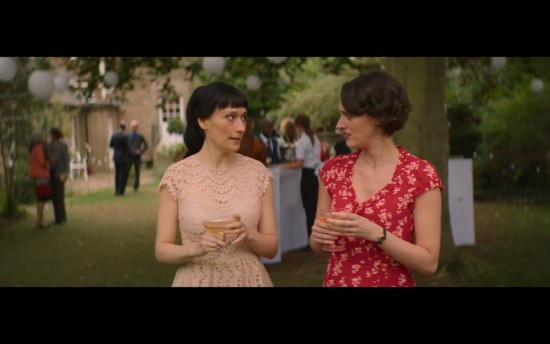
Romantic Truth Revealed.
©Two Brothers Pictures and Amazon Studios
For an instant, the women hold their glasses identically, then Claire drops one hand while she confesses this ultimate truth. The sisters are the same, yet not. Claire’s protective shroud continues to dissolve when their stepmother-to-be presents Fleabag to other guests as the daughter who “has had a miscarriage,” and Claire ups the ante on her truth-telling: “It was my fucking miscarriage,” she bursts. Going further, Claire taunts her husband about her miscarriage (along with everyone else, he had believed it was Fleabag’s), and then storms off: “Oh, and this [their marriage] is over” (Season 2, Episode 6).
Embracing her own desire, Claire channels Fleabag. It is Fleabag, after all, whom the family has come to associate not only with unruly sexual encounters but also with causing narcissistic drama at family gatherings. Flouting the status quo, Claire rejects her people-pleasing persona in order to discard her comfortable life. When Martin refuses to leave, Claire kneels on the floor—a scene resonant of Fleabag’s own confession sequence with The Priest—and begs her husband to go. Even Martin is shocked by Claire’s un-Claire-like behavior: “Huh,” he scoffs, “I didn’t think you’d do that in that dress” (Season 2, Episode 6). Martin recognizes the influence of Claire’s sister here; his parting words are directed to Fleabag, a spiteful “Fuck you” that Fleabag delightfully returns. Once Martin departs, Fleabag reaches down a hand to help Claire off the floor, lifting her into a new life. Having witnessed this transformation, Fleabag coaxes Claire to complete the transition by leaving the wedding to pursue her Finnish love. Claire discards her wig—an artificial marker of change no longer required—and Fleabag watches with pride as Claire stomps away, a move she never would have thought possible until seeing, first-hand, Claire put an end to her marriage.
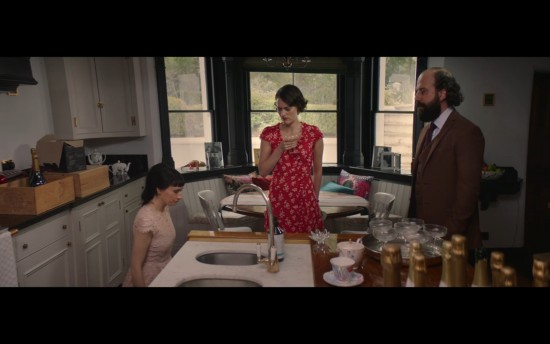
Claire Begs.
©Two Brothers Pictures and Amazon Studios
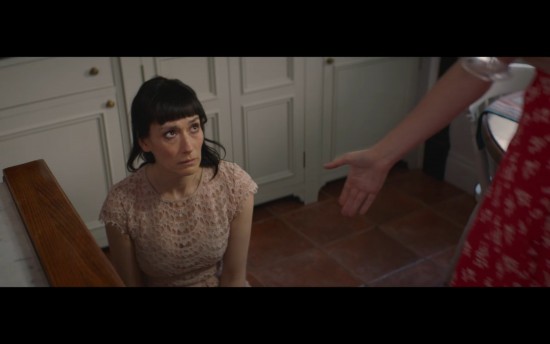
A Sisterly Hand.
©Two Brothers Pictures and Amazon Studios
After observing Claire’s transformation, Fleabag enacts her own, channeling Claire. When The Priest acknowledges that he will not pursue their romantic attachment, Fleabag lets him go. She accepts that it is the right thing to do, the Claire thing to do (at least, the “before” Claire). Fleabag confesses her love, then silences The Priest: “No, no, don’t, no let’s just leave that out there for a second on its own” (Season 2, Episode 6). For a woman who has relied previously on sarcastic asides addressed to an unseen audience, this genuine vulnerability strikes us as new. Letting her admission hang in the air as he walks away, Fleabag accepts the-way-things-are. And she permits an emotional authenticity that both sisters are coming to value.
In Sense and Sensibility, Elinor, too, sees Marianne differently prior to changing herself—though that “change” amounts to performing, externally, sentiments she has always experienced inwardly. During their trip home from London—the denouement of their parallel Bildungsroman journeys—Elinor finds Marianne more balanced than she thought possible:
To Elinor, the observation of the latter [i.e., Marianne’s calmness of spirits] was particularly grateful. She, who had seen her week after week so constantly suffering, oppressed by anguish of heart which she had neither courage to speak of, nor fortitude to conceal, now saw with a joy, which no other could equally share, an apparent composure of mind, which, in being the result as she trusted of serious reflection, must eventually lead her to contentment and cheerfulness. (387)
Marianne’s apparent transformation unsettles Elinor’s reading of Marianne. Elinor’s reflection, though calm, breaks into complicated syntax and overly punctuated phrases that convey her struggle to overturn her sororal preconceptions. She now sees Marianne “suffering” in a manner “conceal[ed]” with “composure” and “serious reflection.” In other words, Elinor sees herself in her sister. Unable previously to detect sense and sensibility in Marianne, even if it were there, Elinor observes these traits blending, and “smil[es] to see the same eager fancy which had been leading [Marianne] to the extreme of languid indolence and selfish repining, now at work in introducing excess into a scheme of such rational employment and virtuous self-controul” (389). Elinor accepts that Marianne’s “eager fancy” can exist in tandem with “rational employment and virtuous self-controul.” One need not exclude the other.
In turn, Marianne reassesses her view of Elinor. She acknowledges the value of traits that she had previously dismissed: “‘Your example was before me,’” she says to Elinor, “‘but to what avail?— . . . Did I imitate your forbearance . . . ? . . . No’” (392). In the end, Marianne accepts her overlap with Elinor. Emerging from her sick room, Marianne commits to balancing recklessness with reticence: rather than pursue an either/or course—either resigning herself to spinsterhood or seeking a fantastical passion of romance novels—Marianne grounds herself in rational domesticity, “placed in a new home, a wife, the mistress of a family, and the patroness of a village” (429–30).
Elinor, too, acts differently after she lets herself see Marianne as both reasonable and passionate. When Edward returns to Barton, Elinor does not speak, but emotes:
Elinor could sit no longer. She almost ran out of the room, and as soon as the door was closed, burst into tears of joy, which at first she thought would never cease. Edward, who had till then looked any where, rather than at her, saw her hurry away and perhaps saw—or even heard, her emotion. (408)
Fleeing to a private space, Elinor lets her façade crack. Her speedy exit repeats actions taken by Marianne, as when the younger sister cannot stand the entrance of Colonel Brandon when she expected Willoughby and so “immediately left the room” (184). With Elinor’s hasty departure, the narrative segues into subtle free indirect discourse, showing us Elinor transparently, as it is her perspective that conjectures whether Edward “perhaps saw—or even heard, her emotion.” Channeling Marianne’s expressive flair, Elinor is “everything by turns but tranquil,” and “require[s] several hours to give sedateness to her spirits” (411–12). She accepts the part of herself that has always been like Marianne.
In the end, both sets of sisters walk similar paths. Where Marianne clings closer to her kin—“‘I shall now live solely for my family. You, my mother, and Margaret, must henceforth be all the world to me’” (393)—Austen aligns the sisters’ marital households to conclude the novel with sororal re-connection: “though sisters, . . . they could live without disagreement between themselves” (431).
In Fleabag’s final shot, Fleabag walks away from the camera headed in the same direction we last saw Claire depart. While the soundtrack strums the Alabama Shakes’ “This Feeling,” Fleabag leaves us behind as well. First looking into the camera at close range (lyrics: “but it feels so nice, to know I’m gonna be all right”), she then turns over her shoulder to shake off the camera from following her (“it wasn’t very hard”), and, after walking down the sidewalk, pauses for one final nostalgic wave (“nobody on my side”) (Season 2, Episode 6). We have, of course, been the ones on her side. In one sense, Fleabag’s direct address has allowed us to replace Boo as Fleabag’s intimate “co-conspirator” (Woods 208). But, in truth, Fleabag has had one true partner all along: as Claire confesses, “The only person I’d run through an airport for is you” (Season 2, Episode 6).
NOTES
1Hirsch 26; Rosowski 49; Ellis 30. On the “female Bildungsroman,” see also Fraiman.
